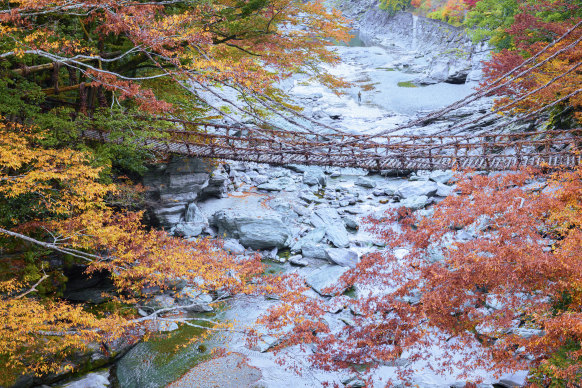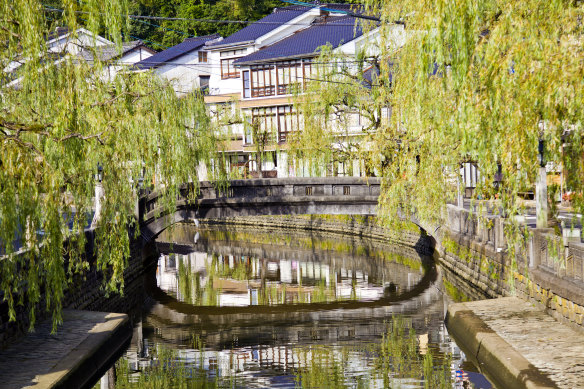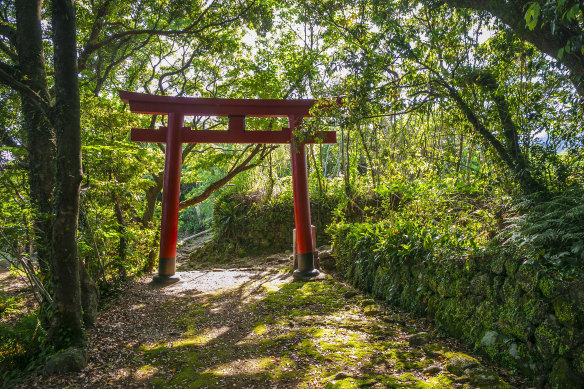This was published 4 months ago
Head away from the big cities and neon lights for a memorable trip to Japan
By Ute Junker
Travelling in Japan can sometimes feel like stepping into a sci-fi movie. From cafes staffed by robots and bullet trains that travel at 300km/h to underground farms and high-tech toilets, a Japanese holiday can take you back to the future.
But this beguiling country also has a very different side. Head away from the big cities and neon lights and soaring skyscrapers are soon replaced by verdant forests and tranquil temples. This is a place where time slows down, where old traditions flourish and where your soul has room to expand. Here are three places to discover Japan done differently.
Splendid solitude in Shikoku

One of the woven bridges in the Iya Valley in Shikoku’s Tokushima Prefecture.Credit: Getty Images
If you have ever experienced a Tokyo rush hour, you probably think of Japan as a crowded country. But even on Japan’s four largest islands there are still plenty of places to escape.
Nowhere is this truer than in the Iya Valley in Shikoku’s Tokushima Prefecture. Long a byword for remoteness, it’s hidden amid a series of rocky gorges and steep mountains, a wild landscape where deer, boar and monkeys roam.
That isolation made it a natural sanctuary for the Taira clan back in the 12th century. The losing side in the Genpei War, which paved the way for the first samurai government in Kamakura, they fled to the Iya Valley in the hope its inaccessibility would provide shelter from their enemies.
The Taira didn’t just rely on the natural shelter provided by the mountains and the fast-flowing, snow-fed river that rushes through the valley. They also wove vines together to create extraordinary bridges that may have lacked stability but provided a last line of defence: should enemies appear, the bridges could simply be cut down, trapping the forces on the other side of the river.
The three woven bridges that still survive today are less precarious than their forerunners, being rebuilt every three years and reinforced by steel cables. Even so, the widely spaced slats and the way they sway with every step make a walk across a vine bridge a great way to get in touch with your inner Indiana Jones.
Other highlights in the area include a trip to the gorgeous Oboke Canyon where, depending on your appetite for adrenaline, you can catch a pleasure boat and cruise gently down the emerald river, or go whitewater rafting on a wilder stretch of water.
Also worth a visit is tiny Nagoro, now known as “the village of the dolls”. Like many other remote Japanese villages, Nagoro’s population is dwindling – these days it has fewer than 20 residents.
One villager, tired of seeing more and more familiar faces disappear, started creating huge dolls which she positioned around the village simulating everyday activities, from relaxing on a front porch to waiting for a bus. The dolls have helped life return to the village in the form of curious tourists coming from all over to see for themselves.
Getting steamy in Kinosaki Onsen

Kinosaki Onsen, two and a half hours from Kyoto, has seven hot springs, all within walking distance.Credit: Getty Images
You can pack light when you visit Kinosaki Onsen – and not just because you will probably be spending much of your time steaming it up in an onsen, the name given both to Japan’s natural hot springs and the bathing facilities that surround them. In this town, the dress code is as relaxed as they come.
People take tradition seriously here. You can see it in the ateliers where artisans practise … not to mention the restaurants, where menus are built around local ingredients.
You see, Kinosaki Onsen, 2½ hours from Kyoto, has seven hot springs, all within walking distance of one another. The first was discovered 1300 years ago, giving the locals plenty of time to perfect the experience for their guests.
When you check in to a Kinosaki ryokan (a traditional guesthouse), you will be issued with a yukata robe and wooden geta sandals, which are traditionally worn when you emerge from an onsen. Here, they are also approved streetwear. No need to choose an outfit before you head to the baths of your choice: just follow the lead of the yukata-clad couples strolling beneath the willows and cherry blossom trees lining the tranquil Otani River as it flows through the centre of town.
That is part of the charm of Kinosaki Onsen: they take traditions seriously here. You can see it in the ateliers where artisans practise the colourful and fast-disappearing art of straw craft, and in the restaurants where menus are built around the best local ingredients, from the melt-in-your-mouth tajima beef (known for its rich marbling) and richly flavoured matsutake mushrooms, only found growing under pine trees, to the matsuba crab, a local species of snow crab that comes into season when the temperatures drop.
One must-try is konotori, or stork rice, remarkable not just for its mild, slightly sweet flavour but for the story behind it. Kinosaki had long been home to a population of oriental white storks, elegant birds with a two-metre wingspan. However, after chemical-heavy industrial farming was introduced in the 1950s, the birds were soon on the brink of extinction.
A captive breeding program finally bore fruit in 2005 when five birds were released. Local rice farmers supported the birds by making their paddy fields stork-friendly, introducing organic growing techniques that helped boost the population of frogs, a key food source for the birds. The storks are now flourishing, and every serve of konotori rice helps ensure their future.
Spirited away on the Kii Peninsula

Kumano Kodo pilgrimage route, Kii Peninsula.Credit: Getty Images
If you are looking for the path less trodden, the Kii Peninsula is not the place to go. You may well be the only person following your chosen trail through sun-dappled woods beneath towering cedar trees, but over the centuries many, many feet have followed the same route.
The pilgrim paths of Honshu’s Kii Peninsula have a long history. Collectively known as the Kumano Kodo, this World Heritage-listed pilgrim network has drawn spiritual seekers for over a thousand years.
Perhaps you can chalk it up to the Kii Peninsula’s spectacular scenery, where ancient forests meet the tranquil sea, but this area has long been Japan’s spiritual centre, sacred to both Buddhist and Shinto believers. Japanese emperors would ritually walk some of these routes, as would the followers of the ascetic Shugendō sect, who chose a particularly arduous path along high-altitude mountain ridges exposed to the elements.
No need to follow their example: there are plenty of more appealing ways to immerse yourself in ancient traditions. The atmospheric Okuno-in mausoleum – studded with thousands of moss-covered tombstones, memorial towers and statues – is believed to be the resting place of Kobo Daishi, or Kukai, the founder of Shingon Buddhism, who lies in “eternal meditation” in a cave on the site. Okuno-in is at its atmospheric best during a night tour, when lanterns cast a soft glow across the area.
If you love a good festival, the Oto Festival, held every February at Kamikura shrine, is electrifying. Thousands of participants compete to run down the vertiginous stone steps from the summit of Mount Kamikura holding torches lit by a sacred fire.
Spiritual traditions are not the Kii Peninsula’s only treasures. The Japanese imperial court has a long history of feasting on local specialities, including fantastic seafood. Much of the latter has traditionally been supplied by the Ama divers, hardy female free-divers who dive to depths of 10 metres without any breathing apparatus to harvest scallops and clams, abalone and fish. A seafood barbecue in the company of these good-humoured women is a tasty way to celebrate their traditions.
Get the best of Sunday Life magazine delivered to your inbox every Sunday morning. Sign up here for our free newsletter.